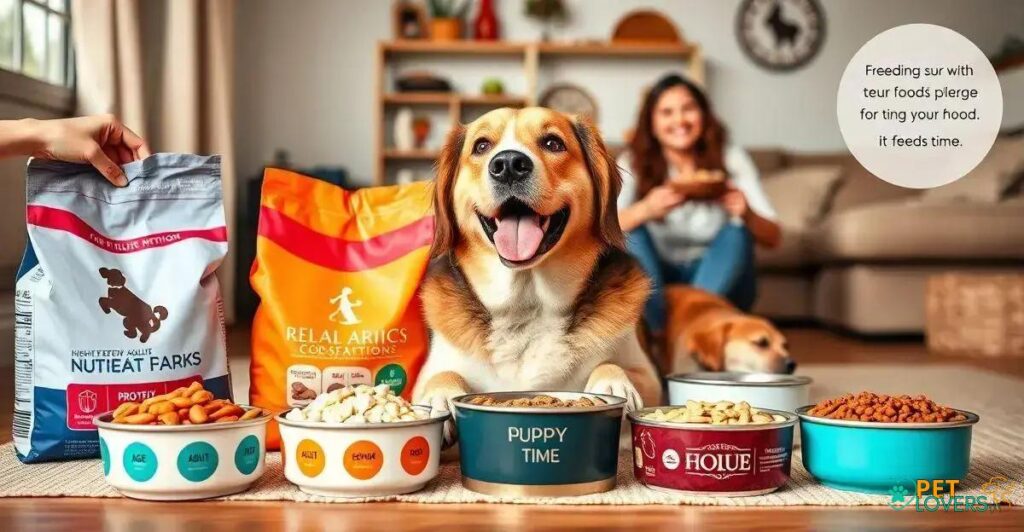When selecting food for your large dog, consider their age, nutritional needs, and any food allergies. Transition to new food gradually, monitor their weight, and adjust portions as needed. It’s important to maintain a consistent feeding schedule and consult your veterinarian for tailored advice.
As a dog owner, you want to ensure your furry friend is getting the nutrients they need to stay healthy and happy.
But with so many food options available, it can be overwhelming to choose the right one for your large dog.
In this post, we’ll explore the best food for large dogs, from choosing the right formula to common food allergies and transitioning to a new diet.
So, let’s get started and discover the secret to feeding your large dog the right food!
Choosing the Right Food for Your Large Dog’s Age
As large dogs age, their nutritional needs change. Puppies, for example, require a diet rich in protein to support their rapid growth, while adult dogs need a balanced diet to maintain their overall health. Senior dogs, on the other hand, may require a diet that helps manage age-related health issues, such as arthritis or joint pain. When choosing food for your large dog, consider their age and adjust their diet accordingly. Consult with your veterinarian to determine the best food for your dog’s specific needs.
Large breed dogs have unique nutritional needs due to their rapid growth rate and increased risk of joint issues. They require a diet that is rich in protein, moderate in fat, and contains essential vitamins and minerals. Look for dog foods that are specifically formulated for large breed dogs and contain ingredients such as glucosamine and chondroitin to support joint health. Additionally, choose a food that is high in fiber to help support digestive health.
Food allergies are a common issue in dogs, and can cause a range of symptoms from skin irritation to gastrointestinal problems. Common food allergens in large dogs include beef, dairy, and soy. If you suspect your large dog has a food allergy, consult with your veterinarian to rule out other potential causes and develop a plan to manage the allergy. You may need to switch to a hypoallergenic diet or add supplements to their food to help alleviate symptoms.
Transitioning your large dog to a new food can be a challenging process, especially if they are picky eaters. To make the transition smooth and stress-free, introduce the new food gradually by mixing it with their current food in small increments. Monitor your dog’s behavior and stool quality, and adjust the ratio of new to old food accordingly. With patience and persistence, your large dog will adapt to their new diet in no time.
Feeding your large dog at home can be a cost-effective and healthy option, as long as you provide a balanced diet and avoid overfeeding. Start by consulting with your veterinarian to determine the best food for your dog’s specific needs and size. Then, choose a high-quality dog food that meets their nutritional requirements. Consider using a measuring cup to ensure you’re feeding the correct amount, and avoid overfeeding by monitoring your dog’s weight and adjusting their food intake accordingly.
Nutritional Needs of Large Breed Dogs
Nutritional Needs of Large Breed Dogs are distinct from those of smaller breeds. Large breed dogs require a diet rich in protein to support their rapid growth rate, moderate in fat to maintain energy levels, and contain essential vitamins and minerals. A well-balanced diet can help prevent joint issues, support digestive health, and promote overall well-being. Consult with your veterinarian to determine the best food for your large breed dog’s specific needs.
Common Food Allergies in Large Dogs are often caused by common ingredients such as beef, dairy, and soy. If your large dog is experiencing skin irritation, gastrointestinal issues, or ear infections, it may be a sign of a food allergy. Consult with your veterinarian to rule out other potential causes and develop a plan to manage the allergy. You may need to switch to a hypoallergenic diet or add supplements to their food to help alleviate symptoms.
Transitioning to a New Food for Your Large Dog requires patience, persistence, and a gradual approach. Introduce the new food gradually by mixing it with their current food in small increments. Monitor your dog’s behavior, appetite, and stool quality, and adjust the ratio of new to old food accordingly. With a smooth transition, your large dog will adapt to their new diet in no time.
Tips for Feeding Your Large Dog at Home include choosing a high-quality dog food that meets their nutritional needs, feeding the correct amount, and avoiding overfeeding. Consider using a measuring cup to ensure accurate feeding, and monitor your dog’s weight and adjust their food intake accordingly. Feeding your large dog at home can be a cost-effective and healthy option, but it requires careful planning and attention to detail.
Common Food Allergies in Large Dogs
Common Food Allergies in Large Dogs can cause a range of symptoms, from skin irritation to gastrointestinal problems.
The most common allergens include beef, dairy, and soy, but other ingredients can also trigger an allergic reaction.
If you suspect your large dog has a food allergy, consult with your veterinarian to rule out other potential causes and develop a plan to manage the allergy.
This may involve switching to a hypoallergenic diet or adding supplements to their food to help alleviate symptoms.
It’s essential to work closely with your veterinarian to determine the best course of action for your dog’s specific needs.
Transitioning to a New Food for Your Large Dog
Transitioning to a new food for your large dog requires a gradual and well-planned approach. Start by introducing the new food in small amounts, mixing it with their current food to prevent digestive upset. Monitor your dog’s behavior, appetite, and stool quality, and adjust the ratio of new to old food accordingly.
It’s also essential to transition slowly, as sudden changes can cause digestive issues. Work with your veterinarian to determine the best transition plan for your large dog’s specific needs and health status.
Tips for Feeding Your Large Dog at Home
Tips for Feeding Your Large Dog at Home include measuring their food carefully to avoid overfeeding, feeding a high-quality dog food that meets their nutritional needs, and providing a consistent feeding schedule.
It’s also important to monitor your dog’s weight and adjust their food intake accordingly to prevent obesity.
Additionally, consider consulting with your veterinarian for personalized feeding recommendations based on your dog’s age, breed, and health status.
By considering your large dog’s age, nutritional needs, and potential food allergies, you can make informed decisions about their diet and ensure they receive the best possible nutrition.
Remember to transition to new foods gradually, monitor their weight and adjust their food intake accordingly, and consult with your veterinarian for personalized feeding recommendations.
With the right approach, you can provide your large dog with a healthy and happy life.
Frequently Asked Questions about Feeding Your Large Dog
What is the best way to transition my large dog to a new food?
Transition your large dog to a new food gradually, mixing the new food with their current food in small increments to prevent digestive upset.
How do I know if my large dog has a food allergy?
Consult with your veterinarian to determine if your large dog has a food allergy and develop a plan to manage the allergy.
What are some common symptoms of a food allergy in large dogs?
Common symptoms of a food allergy in large dogs include skin irritation, gastrointestinal issues, and ear infections.
How often should I feed my large dog?
Feed your large dog according to their age, breed, and health status, and monitor their weight and adjust their food intake accordingly.
Can I feed my large dog at home?
Yes, you can feed your large dog at home, but it’s essential to provide a consistent feeding schedule and monitor their weight and adjust their food intake accordingly.

